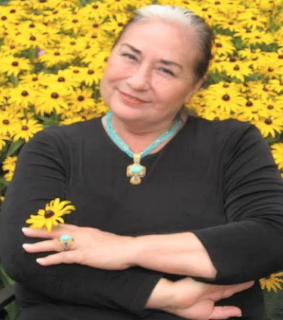Pablita Abeyta facts for kids
Quick facts for kids
Pablita Abeyta
|
|
|---|---|
 |
|
| Born |
Ta-Nez-Bah
July 20, 1953 |
| Died | January 31, 2017 (aged 63) Washington, D.C.
|
| Nationality | Navajo Nation & United States |
| Occupation | Activist, sculptor |
| Parent(s) |
|
Pablita Abeyta (Diné name: Ta-Nez-Bah) was an important Native American activist and sculptor. She was a member of the Navajo Nation. Pablita was born on July 20, 1953, in Gallup, New Mexico, United States. She passed away on January 31, 2017.
Pablita was the oldest daughter of Sylvia Ann (Shipley) Abeyta and the famous artist Narciso Abeyta. Her Navajo name, Ta-Nez-Bah, means "One Who Completes a Circle." Her family came from the Cañoncito Band of the Navajo Reservation in New Mexico. This area was later renamed To'Hajiilee. Pablita earned a special degree called a Master's in Public Affairs. She then worked as a lobbyist for the Navajo Nation in Washington, D.C.
Contents
Early life
Pablita Abeyta was born in Gallup, New Mexico, on July 20, 1953. Both of her parents were artists. Her father was Narciso Abeyta, and her mother was Sylvia Ann (Shipley) Abeyta. Pablita was one of seven children in her family.
All of her siblings were also very artistic. They had skills in things like weaving, making sculptures, and painting. Each child was given a Navajo middle name. This was done to help them stay connected to their Native American heritage. Pablita's Navajo name, "Ta-Nez-Bah," means "One Who Completes a Circle."
Career
Pablita Abeyta had a career that combined helping her community and creating beautiful art.
Activism
Pablita earned her Master of Public Affairs degree in 1983 from the University of New Mexico. After finishing her studies, she became a lobbyist for the Navajo Nation in Washington, D.C.. A lobbyist works to influence lawmakers and government decisions. Pablita worked hard to help pass important laws for Native peoples. These laws included the Safe Drinking Water Act, the Clean Water Act, and the Superfund act. These laws help make sure water is clean and polluted places are cleaned up.
From 1986 to 1988, Pablita worked as a legislative assistant for Ben Nighthorse Campbell. He was a politician in the House of Representatives at that time. In 1988, she joined the Bureau of Indian Affairs. This is a government agency that helps Native American tribes.
In 1991, she became a congressional liaison for the National Museum of the American Indian (NMAI). A liaison helps connect different groups, in this case, the museum with the U.S. Congress. At NMAI, she helped get money for the museum. She also helped get funding for the Smithsonian Institution, which oversees NMAI. Pablita also worked on projects to return Native American cultural items to their tribes. She served as a special assistant to the museum's director until she retired in 2011. She helped with fundraising and made sure tribal leaders could attend important museum events. Pablita received many awards while at NMAI, including the Employee of the Year award. This award is now named in her honor.
Art
As an artist, Pablita Abeyta was known for her sculptures. Her pieces are often described as "smooth, round, and sensuous." When she moved to Washington D.C., her sister gave her a kiln. A kiln is a special oven used to bake clay. Pablita started to experiment with making clay sculptures.
Senator Campbell saw her art and encouraged her to show it in a gallery in Colorado. Her artwork is now part of many private and public collections. These include collections owned by famous people like John McCain and Daniel Inouye. Her art is also displayed at the National Museum of Natural History.
After her death in 2017, one of her pieces was sold at an auction for the first time. This sculpture, called "untitled, two corn maidens," was auctioned in 2020. Another sculpture of a woman she created around 1995 was given to the NMAI in 2008.
See also
 In Spanish: Pablita Abeyta para niños
In Spanish: Pablita Abeyta para niños

